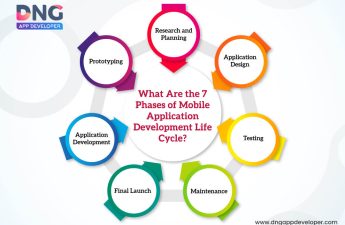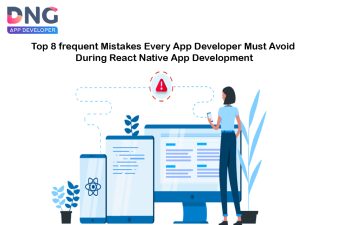There is no doubt that the mobile app market is growing at a rapid pace in today’s fast-paced society. As a result, mobile marketing strategies are becoming more and more intensely competetive. Because of the complexity of the situation, app developers must be very careful about the approach they take when developing mobile apps (including game apps). Mobile application development lifecycle needs to be followed in a systematic way to create a successful application. On this page you will find a list of the top ten steps for creating a successful mobile application.

A Successful Mobile App Can Be Made in Ten Easy Steps
For a successful mobile application, follow these steps
App ideas are the first step in creating a successful mobile application :
A successful mobile application starts with the following considerations:
- Decide on a problem that your app can fix
- Then, decide what your app will do.
Customer benefits from the app should be quantifiable, such as cost savings through productivity enhancements or increased revenue.
Clarification and Identification
Your mobile application’s success will depend on your ability to:
- The application’s target users should always be kept in mind when developing an app. Apps that have a clear vision of their target audience are more likely to succeed.
- Devices to be supported – Devices should be selected based on hardware performance, battery life and ruggedness as well as peripherals that are needed. Coverage, device support, performance, and other features need to be considered when choosing mobile platforms and devices.
- There are a variety of ways to generate revenue from mobile applications, including paid applications, separate app and in-app freemiums, advertisements, subscriptions, and pay per download models. It is possible to generate revenue by using these methods. As a result, the developer’s approach must be tailored to the application. Entice the user to spend money on various aspects of your application is vital for your developer’s success.
Think about your finances and how much you want to set aside for the development, marketing, and eventual release of your app at this point. Listed below is a quick guide to app development costs.
It’s time to create your app
Yet another important factor in an app’s success is how it’s designed. Good UX design and UI-UX means good discoverability. As an app developer, you should focus on the user interface, multi-touch gestures and platform design standards. The user interface (UI) design of an app is increasingly important today, as it plays a crucial role in its success. There are several drag-and-drop app builders on the market. People are becoming more interested in app design because it has the ability to make a lasting impression and ensure that an app is easy to use.

Develop your app in one of three ways: native, web-based or hybrid.
In order to create a successful app, you must choose the right approach. The client’s time and budget constraints should be taken into consideration when developing the app’s backend. The agile methodology is preferred by a number of mobile app developers.
- In order to provide the best user experience, native apps must be developed. These apps are platform-specific and require a certain level of expertise in addition to a certain amount of knowledge. Native apps are expensive and time-consuming to develop, but they offer the best user experience of all the options.
- Development of web-based applications is relatively quick and inexpensive, and they can run on a variety of platforms. A combination of HTML5, CSS, and JavaScript is used to create them. There is less power in these web apps compared to native apps.
- Any app can be using a hybrid application development approach, which is the newest way to do so. There are two ways to do this: using prebuilt native containers and on-the-fly web coding. To create unique features and gain access to APIs not yet available through JavaScript, the developer augments the web code with native language.
Create a prototype for your app.
A prototype is created after the approach has been determined. Actually, it’s the process of taking your idea and turning it into a working application with basic functionality. You can sell your idea more easily with a prototype because you can show the tangible benefits instead of just visualising or reading product description. If you’re trying to find licensees or work with manufacturers, it can be very helpful. Share the prototype app with testers for functional testing, and you’ll get a sense of what changes should be made so that it becomes a successful mobile application.
Don’t forget to take precautions to protect your app against unauthorised usage and data access, even when you’re just working on a prototype.
You will have a difficult time getting your application on the market without a marketing strategy in place. Learn how to create an effective mobile app marketing strategy with our free eBook.
Install an appropriate analytics tool as the sixth step
As well, you’ll want a way to keep track of how many people are visiting your site, how they got there and what you can do to keep them coming back.
To help with this, there are a number of mobile analytics tools available, including
- Google Analytics
- Firebase
- Mixpanel
- Preemptive
Data sciences, such as predictive analytics, are becoming more prevalent in mobile apps, which can make them more marketable.
Seventh step: Identify your test subjects: Consider what they have to say and incorporate it into your plans
When it comes to getting feedback from your target audience, beta testing is the first opportunity to do it. Your app will be more visible in the App Store if you do this. App store exposure is boosted as a result of this. A successful mobile app also requires the identification of beta testers.
Launching the beta version:
- Establishing a clear understanding of your target audience is crucial. As a result, you will be able to identify the right beta testers when you are recruiting them. A thorough market analysis is aided by early market research, which facilitates beta testing.
- Prevent device-specific bugs by considering the majority of devices before beta testing your app on different platforms. Alpha testing with a small number of users allows for maximum bug removal. A device coverage plan is also important for ensuring the quality of a smartphone app’s functionality.
- Be specific about what you want to achieve – Beta testing is the best way to get real feedback from potential customers. You can learn more about your target market and their needs. Assembling a list of objectives for beta testing helps to keep the project on track. These goals reduce the risk of launching a new product.
Release/Deploy the application
An app’s release to test and live environments must be carefully planned. Deployment Management’s primary goal is to protect the integrity of the live environment and ensure that the correct components are released.
Next, you’ll need to collect data.
In the last decade, the number of people using mobile apps has increased dramatically. So it’s crucial to collect accurate metrics. It is becoming more and more important to collect accurate metrics from mobile applications as the number of users increases. As a result, web analytics is used to measure apps.
The following are some important input metrics to keep in mind:
- Analysis of the funnel shows why users are not completing desired actions, such as in-app purchases or ad clicks.
- By measuring social sharing, you can see which aspects of your app are grabbing the attention of your users.
- Comparing user behaviour to demographic data
- The ability to track time and location gives you a better understanding of how your app is being used.
- It’s also important to keep track of your users’ evolving behaviour.
Improve and add new features to your app.
After you’ve gathered the data, it’s time to upgrade your app with new features and improvements. The usability of a mobile app that lacks innovative features decreases over time. Adding new features to your app increases its visibility and downloads. Always keep your app up-to-date in order to comply with new guidelines offered by the various platforms.
As you can see, there are a number of things to keep in mind when creating an app. If you follow these steps, you can create a successful app. But it’s almost impossibly to pinpoint the exact steps that lead to a successful app.
If you want your app to be successful, especially for small businesses, you’ll need to do this, even though it’s not part of the steps to “make” an app. As soon as your app is released, if you don’t do a good job marketing it, it’s likely to get lost in the sea of apps available on the various Android app and ios app stores. Ensure that your app is well-marketed. This is an area where social media can be useful. However, it is highly recommended that you take advantage of this bonus step in order to create a successful mobile application.
Get started today by utilising mobile marketing to promote your company!




1 thought on “How to make a successful mobile application?”
Comments are closed.